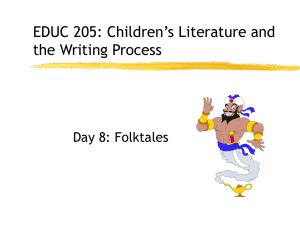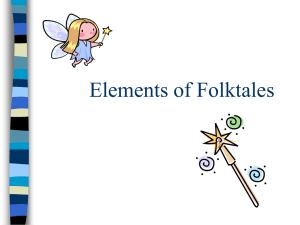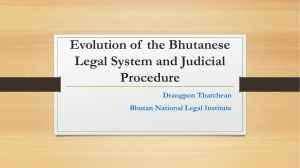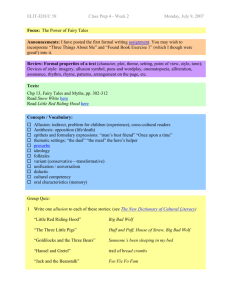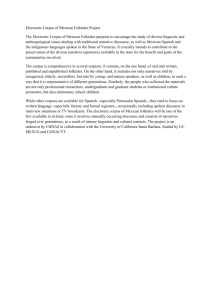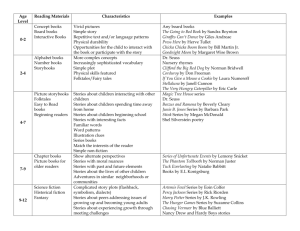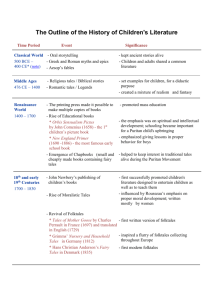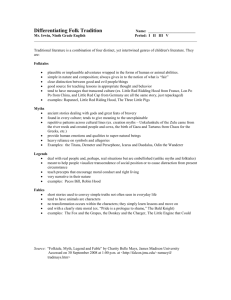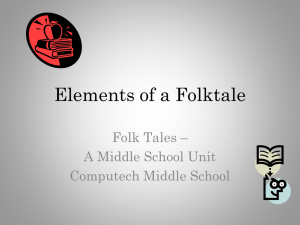Bhutanese Folktales: Common Man's Media with Missions for Society
advertisement
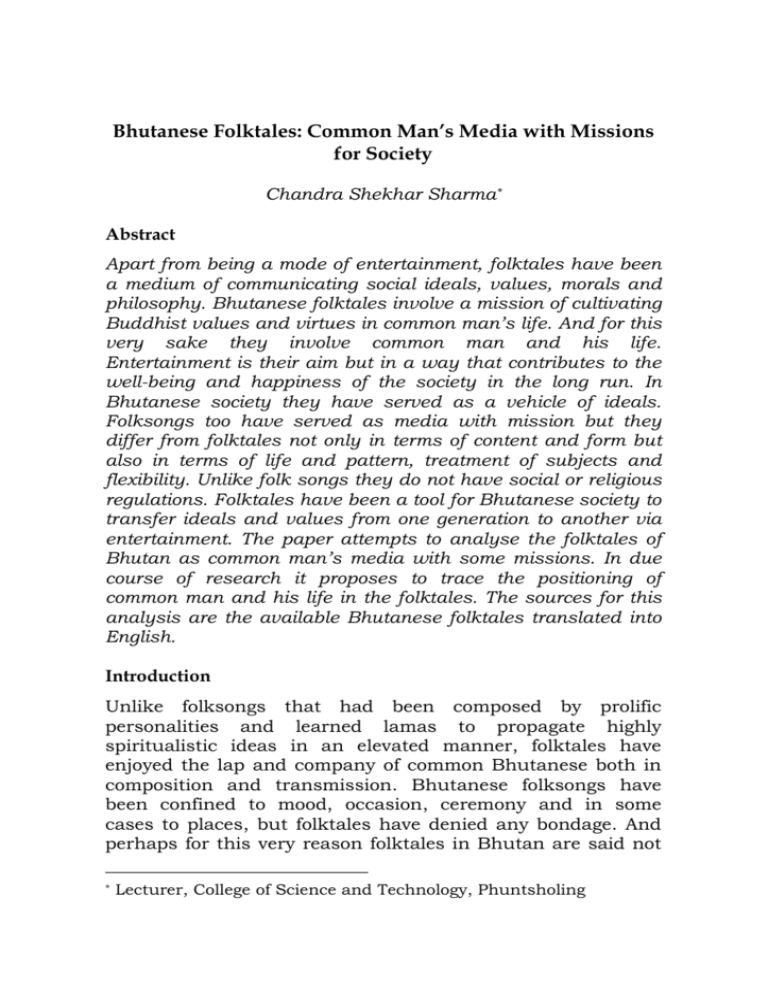
Bhutanese Folktales: Common Man’s Media with Missions for Society Chandra Shekhar Sharma* Abstract Apart from being a mode of entertainment, folktales have been a medium of communicating social ideals, values, morals and philosophy. Bhutanese folktales involve a mission of cultivating Buddhist values and virtues in common man’s life. And for this very sake they involve common man and his life. Entertainment is their aim but in a way that contributes to the well-being and happiness of the society in the long run. In Bhutanese society they have served as a vehicle of ideals. Folksongs too have served as media with mission but they differ from folktales not only in terms of content and form but also in terms of life and pattern, treatment of subjects and flexibility. Unlike folk songs they do not have social or religious regulations. Folktales have been a tool for Bhutanese society to transfer ideals and values from one generation to another via entertainment. The paper attempts to analyse the folktales of Bhutan as common man’s media with some missions. In due course of research it proposes to trace the positioning of common man and his life in the folktales. The sources for this analysis are the available Bhutanese folktales translated into English. Introduction Unlike folksongs that had been composed by prolific personalities and learned lamas to propagate highly spiritualistic ideas in an elevated manner, folktales have enjoyed the lap and company of common Bhutanese both in composition and transmission. Bhutanese folksongs have been confined to mood, occasion, ceremony and in some cases to places, but folktales have denied any bondage. And perhaps for this very reason folktales in Bhutan are said not * Lecturer, College of Science and Technology, Phuntsholing Journal of Bhutan Studies to be just ‘narrated’ but to be ‘released’ or ‘unraveled’ in leisure hours of life – an act of not ‘just killing time’ but of enjoying leisure in a creative manner. This very inevitable and peculiar fact about the process of story telling in Bhutan has been attested by Kunzang Choden and Tandin Dorji. Choden says “In Bhutanese tradition stories, fables and legends are not told but are unraveled (shigai in Bumthangkha) and released (tangshi in Dzongkha)…these concept of releasing and unraveling are invested with much significance.”1 These terms, shigai or tangshi, are related to information, which implies that our folktales are media with a mission of dissemination of information and transfer of knowledge along with entertainment. It has been quoted by different scholars that before the introduction of a Western system of education in the sixties of the past century, there was only monastic education in the kingdom. However I feel that this is not true for such statements overlook the educational aspects of folklore and its significant contribution in the shaping of the society. If education is a philosophical concept imbibing ideals of equality, freedom, justice and harmony, then the process of folktale narration is also a type of education. Keeping in view the pedagogical aspects of our folktales it will be right to say that before the introduction of Western education, Bhutan had two education systems: monastic education and the nonformal social education system of folklore. The monastic education system was not accessible to everyone. Besides this, the strict administration in monastic education disinterested adolescents. Some would run away or others would give up for the sake of establishing family. On top of all these facts, social structure also demanded some people to work in fields and at home. If everybody became a geylong (monk) or lama and devoted themselves to scriptures 1 Choden, Kunzang (2002), p. xi. 84 Bhutanese Folktales: Common Man’s Media and spiritualism, who would be left to do regular social chores? Sex was another discrimination in monastic education. Females were not privileged to pursue monastic education. Dorji Penjore writes, “…the monastic education system that provided Buddhist education was accessible only to a few privileged families. Women were excluded with exception of a few nuns.”2 In her novel The Circle of Karma, Kunzang Choden also mentions such discrimination. Her protagonist Tshomo is not allowed to read and write and attend traditional educational classes conducted by her father at home just for the reason that, “You are a girl. You are different. You learn other things that will make you good woman and a good wife. Learn to cook, weave and all those things. A woman does not need how to read and write, Father says quietly but sternly when she asks him to teach.”3 In such a social scenario it became very necessary to impart basic education about social values, prevailing beliefs, common sense, general knowledge and religious values to those underprivileged ones. Folktales shared this responsibility as a media not only for entertainment but also for education. But the role of folktales as a media has been improperly acknowledged. Dasho Kinley Dorji too skips folk tales in his list of traditional media while saying, “Our scholars now remind us of the centuries-old media that we had in Bhutan- the mani walls, prayer flags, the festivals and dances.”4 Before delving into the topic it isn’t amiss to have a cursory glance over the concept of media. Normally when we think of media we are conscious of only the modern means of 2 3 4 Penjore, Dorji (2005), p. 51. Choden, Kunzang (2005), p. 21. Dorji, Kinley (2006), p. 4. 85 Journal of Bhutan Studies information dissemination. We skip over the traditional oral culture and its role as media. Folklores are seldom recognised for their role as media. Françoise Pommaret rightly says, “When speaking today of media, we immediately think of the press, TV, internet, films, etc., therefore implying that the traditional society has no media, no form of public communication.”5 Thus the role of folklore and traditional means as an information and entertainment media rarely come to our mind. Various definitions can be given to elaborate the term ‘media’. In a broader sense, anything that serves or propagates information is media. In this very sense media is devoted to “…cultivating the public mind...performing a public function.”6 Media has its role. It caters to the demands of society, time, situation and context. Based upon these factors, different types of media emerge from time to time. Various literatures and theories may be cited to demarcate the role of media in any society. Pommaret points out: “…media transmit values that are often cultural or religious oriented, and that the subliminal messages that any media conveys, are therefore reflection of the culture in which the media themselves are produced.”7 This statement has been used in the context of dances but it also proves that folktales are media with a mission in our society. Another appropriate observation from the Bhutanese point of view about media’s role appears in Dasho Dorji’s following lines: “Media must help society to understand change and, in the process, define and promote right values, including public values…responsible for culture, happiness, liberty, 5 6 7 Pommaret, Françoise (2006), p. 26. Dorji, Kinley (2006), p. 4. Pommaret, Françoise (2006), p. 26. 86 Bhutanese Folktales: Common Man’s Media spirituality, even survival of society.”8 The role of Bhutanese folktales must be evaluated in the shadow of the above sentences. Each folktale is a medium of communication, and also a process of communication in itself. Communication is defined as a process of transfer of ideas or information from one person to other for a definite purpose. Communicator, listener, ideas or information, medium, feedback or response are the basic requisites for a talk to be communication. It is a two way process, i.e. both the communicator (speaker) and listeners actively participate in it. Our folktales not only involve these requisites but also ensure the other important feature ‘feedback’ which is essential in the communication cycle (illustrated below). Message Communicator Listener Feedback In the process of storytelling in Bhutan the person who narrates the tale is a communicator. The communicator has a purpose behind telling the story, and this purpose may be entertaining the listener or providing them moral lessons. The message in the story is not only verbal (in the form of words) but also lies in the sentiments and expressions that are employed by the narrator. The sender employs a variety of measures like variance in pitch, intonation, gestures, pauses in between his/her narration to portray different human sentiments like- melancholy, anger, sadness, jest, happiness, and joy. 8 Dorji, Kinley (2006), p. 4-5. 87 Journal of Bhutan Studies “The art of narration is not limited to the use of beautiful expressions, figures of speech and ritualistic formulas but is also equally animated and made lively through gestures and varying intonation of the voice of the narrator”9 Mention must be made here to the commencing and closure of the process of storytelling. The process starts with ‘Dangbo…Dingbo’ (Long long ago) and ‘Henma henma’ (Once upon a time) to take the listeners far away from the fatigue and penury of their real life to a wonderland of fantasy/imagination. This increases the anxiousness of the listeners. Similarly the methodology of ending the story is also worth noting. The session (not the tale) ends with a note to bring back the listeners to the real world by using various closure formulae. Such an artful narration contributes to effective discharge of concepts and in enhancing proper encoding and decoding of the message behind a tale. The receiver, the listener, listens to the story and deciphers or interprets the message and gives a proper feedback. Basically media has two basic roles to play in the society. Firstly, it aims to entertain. Secondly, it aims to bring behavioural change in the audience. The effectiveness of the message conveyed or the understanding is judged by the feedbacks. We have two types of feedbacks in context storytelling sessions: 1. Immediate/ instantaneous feedback nonverbal) 2. Long term feedback (behavioural) (verbal or Immediate or instantaneous feedbacks are the immediate responses of listeners to the narrator. These can be either verbal, (i.e. in the form of a hum or word) or nonverbal (i.e. can be expressed with expressions). They help the sender in knowing the attentiveness of the listener in addition to keeping them involved by maintaining interest, curiosity and 9 Dorji, Tandin (2002), p. 10. 88 Bhutanese Folktales: Common Man’s Media anxiousness among the listeners. Such feedbacks ensure active participation, continuous interaction and active listening. While the narrator narrates the tale, the audience produces a humming sound “Umm..mm” which implies ‘that the story is listened by the audience’. This is a common response but there are some other responses too. To express their sympathy or signify their listening the listener may say “Aye”, which roughly means ‘yes’ and when the story takes turn to some astonishment or reveals suspense the audience express their surprise or shock by “Yaahlamah” or “ayi wha”. Another usual response that follows the sequence one “Aei” or “tse ni” (in Bumthangkha) or “delay” that means ‘then’. This instantaneous feedback ensures that the message encoded has been decoded properly. Being a two way process, communication requires active participation of listeners. While the speaker’s participation remains active by speaking, there is a risk that listener’s participation may become passive. To avoid such risk and to ensure his/her participation a feedback technique has been intelligently incorporated. There are three purposes behind caring for instantaneous feedback. Firstly, to ensure that audience listens to and not just hears the tales, because one can provide empathetic response when one listens properly. Secondly, it is also to ensure correct decoding, and thirdly to keep the audience active by making them feel that presence is valued. This instantaneous feedback is not very natural but has been imbibed in the listener society as a required custom of storytelling or listening activity. Kunzang Choden reasons: “This customs is to prevent the spirits from listening to the stories and stealing them. As long as human beings responds and indicates that the story is being listened to, the spirits cannot steal them.”10 10 Choden, Kunzang (2002), p. xiv. 89 Journal of Bhutan Studies Another reason that I came across while undergoing this work is the following. The silence or lull during the storytelling session may point to the absence of the listener and will invite a demon whose one tooth touches the sky and the other to the earth, to take away (steal) the story. These demons or spirits are none but the inattentiveness of the listeners, which will surely kill the stories or vanish the stories from memory of common man. Through such imbibed trait the listeners are kept abound with the discourse so that they can in future narrate the same to others. Coming back to the long-term feedback, we must look at behavioural changes. Folktales as a media try to imbibe some cultural traits in the listeners, and thus act as media, a vehicle. Various tales are narrated to fill the education gap in the younger generation. Certain social values are much related to Bhutanese society. As recognised by Curriculum and Professional Support Division (CAPSD) these are: “Love for Family, Cleanliness, Obedience to Parents and Teachers, Love for Animals, Honesty, Friendliness, Thankfulness to Parents, Teachers and Friends, Love for Plants, Respect for Teachers and Friends, Punctuality, Love for Friends, Care for Properties, Responsibility, Generosity, Obedience, Love for Friends and Family, Cleanliness, Helpfulness, Thankfulness, Punctuality, Respect, Helpfulness, Responsibility, Friendliness, Loyalty, Unity, Honesty and Gratitude.”11 These values are not new to Bhutanese oral society. It has long back recognised these values and their importance, and has disseminated them through folktales targeted to entertain the young and to bring in them some behavioural changes so that the society can be happier and more prosperous. These behavioural changes were long-term feedback for the entire senior generation and society. The imbibing of such values could have been done by monastic education too but it wasn’t available to everyone. So what the mask dances and folksongs 11 Teaching Learning to Be, (2001). 90 Bhutanese Folktales: Common Man’s Media would do occasionally with some limitations, was done with a great ease by tales. This procedure of entertaining and educating was not just limited to academic clergy or theocratic scholars but to the common man whose tool was imagination and simplicity, and whose aim was a peaceful and harmonised society. Originating from the common man as a common man’s media, these stories involve common man’s life outlook and perception on different themes. Highly spiritual lessons of sin, salvation, suffering, offerings, metaphysics, complexities of transcendentalism and philosophy doesn’t lie in the scope of folktales for they are far behind the understanding of a layman. But within the scope lies the social life of human beings and the common man’s perception and attitude. Apart from communicating values, Bhutanese folktales have different roles to play in society. Dorji Penjore identifies four roles of folktales in Bhutan. 1. 2. 3. 4. Educating the children Entertainment and communication Repositories of culture and value Folktales and spiritual needs12 The first and the second role are umbrella roles that cover the third and the fourth one. In addition to this, as Tandin Dorji mentions, tales have also been used to ward off evil spirits who have haunted a person.13 The functions of Bhutanese folktales can be summed up into following categories. 1. 2. 3. 4. 5. Communication Entertainment Education Enhancing Social Structure Imbibing socio-cultural virtues, promoting right Penjore, Dorji (2005), pp. 53-56. Dorji, Tandin (2002), p. 7. Dorji mentions the way in which tales are told for this purpose. 12 13 91 Journal of Bhutan Studies virtues, and cultivating minds 6. Treatment Anytime, anyone, anywhere Folktales are ‘released’ and ‘unraveled’. But when? Who? Where? Anyone can release it any time. Like songs and mask dances they aren’t bound to any customary chains. Whenever wherever there is audience and someone willing to take charge of being narrator, the session can take the shape. Tales are told in leisure hours of life, where the storyteller and listener have ample of time to stroll in the mystic world and enjoy its realms. We can bifurcate natural story telling session into two: social storytelling sessions and family storytelling sessions. In families, the elders start the session after dinner, after arranging bed. All the children and the younger ones sit or lay around the ‘thap’ or ‘bukhari’ and the tale is released to enjoy and decipher the hidden meanings. The listeners will from time to time, give their verbal feedback to let the storyteller know that they are listening. This is a typical example of family storytelling sessions. During the day the old and young are busy at work, so night is the only time where both can find time to enjoy and interact. Thus storytelling sessions appears to be held normally at night. A social storytelling session involves different members of society. Such sessions appear to be less frequent than the family ones because the population and settlements are scattered. Yet some authors say that it has been a common phenomenon. Kunzang Choden says that it was not only night when tales were ‘released’ but they were also narrated during day and that too in social gatherings. “As I reminisce now of the story telling sessions, I see a circle of adults and children relaxing in the late afternoon sun, in the West Gate field of Ugyen Choling Naktsang, listening in rapt attention to every word of the story teller. At other times it was the evening sitting around a charcoal 92 Bhutanese Folktales: Common Man’s Media brazier in the flickering light of lawang. As the flickering light cast remarkable arrays of shadows, the images from the stories came to life and became real.”14 But these social gatherings appear to be occasional and not as frequent and as usual as storytelling sessions within the family. Anyone who remembers tales, can keep the audience glued and has confidence in the art of narrating can perform the task. Male or female, rich or poor, young or old, anyone can tell a tale. Choden in the preface to her collection talks about Bhutanese men and women who had told her tales. Wangmo asserts of an old man narrating her stories. Tandin Dorji’s organised storytelling sessions too had narrators from a wide spectrum of society. There is no discrimination. Similarly, place doesn’t matter; whether it is an open yard or room or field, everything holds good for this media. There is restriction to time; it can be day or night. Scholarship in Bhutanese folktales Print media in Bhutan gained momentum from the last decade of the twentieth century. Getting something published was a tougher job before. Printing and publishing jobs were mainly outsourced and if they were done within the kingdom the publishers were the authors themselves. Sometimes the publication was self-sponsored; sometimes international agencies sponsored the job of printing and publishing. Amidst these situations, translation of folktales into English and getting them printed and published was a challenge. Tandin Dorji notes “… the scarcity of writing and printing facilities compounded the difficulty and consequently the larger section remained illiterate even after schools were opened and facilities provided free of cost, the documentation took quite sometime to jump from spring board”15 14 15 Choden, Kunzang (2002), p. xii. Dorji, Tandin (2002), p. 5. 93 Journal of Bhutan Studies In addition to these facts, poor readership and illiteracy should also be taken into consideration. Buying and reading books happened to be a less preferred recreational activity than other hobbies. And those who had it were very few. School-going children, who comprise a major reading group, still depend on school libraries. But now the challenges are being challenged. The kingdom has three newspapers, and some publishers with investment attitude and modern printing facilities. The first attempt to collect folktales and publish them in the form of a book was from Dasho Sherab Thaye. It was in 1984 when Dasho Thaye published his debut collection of folktales from Bhutan titled Dzongkha Short Stories (Book One). This pioneering work was published in New Delhi, India. His love for this venture did not end up with the first volume seeing the light of the day. Two years later in 1986, two volumes of folktales with same titles came into existence. But these two volumes did not hunt any foreign publisher; these volumes were published in Thimphu. These stories were in Dzongkha and hence foreigners or those who lacked competency in Dzongkha were unaware of the world of Bhutanese folktales. What unveiled the treasures hidden in the oral prose of Bhutan to the non-Dzongkha speaking community were the compilations of translations of folktales. Before any Bhutanese could venture into translating the folktales into English and publishing them in a collection, Kusum Kapur, an Indian brought a collection to the stands. Kumar undertook the first sincere attempt of translating Bhutanese stories and getting them published. During her two-year stay in the kingdom she not only collected the stories but also laboured on their translation. Her collection of folktales Tales from the Dragon Country was published in 1991 in New Delhi. Kunzang Choden is a much-praised Bhutanese female writer. Her literary life began with a popular collection of folktales translated into English. This collection of folktales and legends which is titled as Folktales from Bhutan saw light in 94 Bhutanese Folktales: Common Man’s Media 1993. It was published from Bangkok, Thailand. A full time writer by profession and passion, Choden is a reputed author in the kingdom. Her long stay in India for education made her feel the importance of her ethnic identity. This self-realisation inched her towards collecting, compiling and translating folktales, which came in the form of a book. Yeti, like UFOs, have been haunting learned and common people as well till date. Choden’s passion for tales took her to find yeti but not in snow capped mountains, rather in Bhutanese oral tradition. Her Bhutanese Tales of Yeti which came out in 1997 contains popular folktales that involve Yeti as a character. These tales tells us that Bhutanese society too had some perceptions about yeti. This collection was also published from Thailand. In the same year came another collection of folktales, Tales from Rural Bhutan, was published from Thimphu. Her collections have made a significant contribution in popularising the tales in and outside Bhutan. Another female writer who gained repute in collecting folklore and getting them published is Kinley Wangmo. Her collection of folktales in Dzongkha Druk gi Lozey dang Tangyu Natsho ge came out in 1995; two years after Choden’s collection in English. Francoise Pommaret mentions this as “a longer Dzongkha Version in which three short versified ballads (lozey) appears”16 In 1997 Wangmo published Tales from Rural Bhutan. This collection was edited by Karma Singye and was published with help of financial assistance of Helvetas. While Choden’s inclination towards folktales and their effortful compilation symbolises a yearning for yore and ethnic identity, Wangmo’s collection symbolises external influences. She asserts, “I met Ap Chethey in the spring of 1993, while traveling 16 Pommaret, Françoise (2000), p. 146. 95 Journal of Bhutan Studies the country with Ms. Claudia Meier, a Swiss writer of folktales who, incidentally gave me the idea and the encouragement for this and earlier book I have published in Dzongkha.”17 The year 1998 found yet another collection Folktales of Bhutan by Rita Thomas published from New Delhi. Pommaret introduces one more writer, Tshering Gyeltshen, in her paper. She writes, “Tshering Gyeltshen has put in writing a collection of popular stories which have ribald and humourous tone ”18 But she doesn’t clearly mention whether the “popular stories” are folktales or fictional creations of his own? In 2002 came another collection by Rinzin Rinzin titled Talisman of Good Fortune and Other Stories from Rural Bhutan. In 2004 Gopilal Acharya, former journalist with Kuensel and currently editor with Bhutan Times, also came up with a slim collection of folktales titled, Bhutanese Folktales- from East and the South; this collection was published in Thimphu. In his paper, Dorji Penjore cites his paper “Was it Yeti or Deity” as ‘forthcoming’ and “Shenje’s Horn” as ‘draft’. If these are collections of folktales they will certainly enrich the scholarship in folktales. Analytical works on folktales took some time to come up. This may be because of two reasons. Firstly such works couldn’t find a proper platform and were less encouraged for their utility in the society. Secondly, late compilation of folktales delayed the focus of the people who could undergo such studies. The first analytical paper on folktales, “Folktale Narration: A Retreating Tradition” was produced by Tandin Dorji, a history Lecturer at Sherubtse College, published in JBS (Journal of Bhutan Studies) in 2002. His paper was an outcome of 17 18 Wangmo, Kinley (1997), p. 7. Pommaret, Françoise (2000), p. 145. 96 Bhutanese Folktales: Common Man’s Media detailed research work that included organising storytelling sessions and surveys. Later Dorji Penjore, researcher at CBS, came up with a paper “Folktales and Education: Role of Bhutanese folktales in value Transmission” in 2005. This was published in the 12th volume of JBS. Steve Evans, a Communications Specialist at International Center for Ethnographic Studies, Atlanta, has added three papers that address the context of Bhutanese folktales. “Tears and Laughter: Promoting Gross National Happiness through the Rich Oral Tradition and Heritage of Bhutan” appears in Gross National Happiness and Development published by CBS. His other two papers, “An Analysis of Meme Haylay Haylay and His Turquoise” and “Preserving Consciousness of a Nation: GNH in Bhutan Through her Rich Oral Traditions”, both secured room in volume 15 of the JBS. Common man’s life and perception in folktales The majority of folktales are centered on the life of common man for they have been their media. These folktales provide an interesting insight into the life and perception of common Bhutanese. Folktales of Bhutan can be broadly classified into following categories: 1. Fables or animal tales where the characters are only animals and they speak, interact and practice social values. 2. Animal-human interaction tales in which human beings interact with animals and birds. 3. Rich versus poor tales. These tales project virtues in their proclamation. 4. Demon/ghost tales (Sinpo, ‘ghost’). These often project victory of poor fellows over demons and ghosts. 5. Idiot tales depicting idiots and narrating their follies. 6. Tales of disguise. The common themes on which these tales run are very much related to the harmonised and peaceful society. Some of the themes can be summed up as: 97 Journal of Bhutan Studies 1. Upholding and teaching about the common social virtues 2. Instilling the philosophy of karma 3. Imbibing socio-cultural and religious beliefs As the folktales are released by the common man it is quite inevitable that they involve the social life and pattern and the values he perceives for the betterment of society. The tales have a lively pattern of social life that comprise poor, rich, as well as spiritual and mystic beings. Our folktales provide hints about our social structure. Most of our characters are poor (economically backward) who would either attend to the duties or orders conveyed by the rich or would just survive with their small harvest. Other than rich there are royals. This simply points that the Bhutanese society, even in those times was divided into three classes depending on privileges and economy. These were royals, rich and poor with their population in increasing order and economic condition and privileges in decreasing order in the series. This gives a pyramidical structure of the society. The Royals The Rich The Poor Dorji Penjore has a similar view. “At the apex of social and political hierarchy are the kings, who are supported by wise ministers and retinue of loyal courtiers. Persons working as court servants are held in highest esteem. The protagonist - usually a poor boy - soon to become king himself is seen serving the king. Lamas, 98 Bhutanese Folktales: Common Man’s Media monks, gomchens, astrologers, rich men, cattle traders, businessmen fill the second stratum. They are mostly assigned secondary roles to move the plot. In the last group are the poor people and their children, hunters, fishermen, farmers, tseri-cultivators, beggars, shepherds, orphans, etc.”19 It is the last group that finds a prominent place in our folktales and whose presence and actions are justified and celebrated over the first two groups. Another part of the social structure is the means of survival. Our folktales attest that farming and cattle-rearing happened to be the two activities on which the survival of the society was largely dependent. Apart from serving the upper strata it was the main activity of the poor in their life. Whereas the royals happened to be largely devoted and dependent on the administrative system, and the rich were related to trading in addition to farming and cattle rearing, the poor mainly depended on farming; their other means of earning was serving the upper strata. In the stories like “The Boy Who Went to Buy Cows”, “Meme Haylay Haylay”, “The Mother and the Ghost”, “Bum Dolay Serba and Bo Serba Tung Tung”, “The Adventures of Poor Boy”, “Acho Tsagye”, “Gyalpo Migkarla”, “Bum Sing Sing Yang Donma”, “Ap Brapchu”, “Lame Monkey”, “P’Chekay- the Man…”, “The Story of the Lazy Boy”, “The Borrowed Gho”, etc, the primary activity of the poor was farming. In some stories they barter the things they produce like in Meme Haylay Haylay, The Shepherd, and The Lazy Boy. But they never barter their fields, which shows the highest value they had for their fields. These fields and environment are symbols of productivity and life and hence are highly valued in folktales. In fact, folktales teach that fields and cattle are loveable possessions and should not be bartered with anything else because the survival of the society basically depends on them. 19 Penjore, Dorji (2005), p. 57. 99 Journal of Bhutan Studies Some characters rely on cattle-rearing. The number of cattle, especially number of cows, one owns implies one’s wealth. But there is an interesting factor that is revealed in our stories regarding society and its structure. The job of looking after cattle is not confined to any class or sex; anyone whether rich or poor, male or female, young or old, can go behind the herd. In the tales “The Boys Who Went to Buy Cows”, “Bum Dolay Penzom and Bo Serba Tung Tung”, “Gyalpo Migkarla”, “The Borrowed Gho”, etc, the poor as well as the rich come to the pastures with their herds. In noting this, the folktales preach that no work is mean and every work is for everyone unless incapable of doing so. In Bhutanese folktales pasture acts as a ground for interaction and adventure between rich and poor, supernatural and natural, mystic and real. It also symbolises its openness for everyone. Not only males but females too are actively involved in this activity. Bum Dolay Penzom (“Bum Dolay Penzom and Bo Serba Tung Tung”), Goke Zangmoi Buthi (“The Borrowed Gho”), Ashi Yulidolma, Ashi Sarlidolma and Ashi Dunglidolma (“Ashi Dunglidolma”) are rich girls who go to pastures to take care of the finest possession and it is here that they meet smart guys from poor background who prove themselves to be their worthiest and most suitable life partners. It is also apt to cite some other characters like The Girl (“Aming Niwa”), The Poor Boy (“The Boys Who Went to Buy Cows”), The Boy (“The Shepherd”), The Dumb Boy (“How a Bull becomes a Tiger”), P’Chekay (“P’Chekay”), and Meme Haylay Haylay who didn’t find their life partners but indeed meet some adventures that portray their inner strength and metamorphism in life. While the girl in Aming Niwa encounters a mouse by chance who turns her life happier, the poor boy encountered a she-demon. Thus pasture proves to be an adventurous land, a juncture that not only twists the tale but also metamorphoses the lives of the characters. The tales caution that pastures are not only where cattle graze but are lands full of promises, no less than fertile fields, that can provide happiness for Bhutanese folks. These stories cultivate an understanding that going to pastures is not a 100 Bhutanese Folktales: Common Man’s Media boring activity nor a risk and in case anything unpredictable comes, it should be faced bravely and honestly. With pastures and fields is connected the philosophy behind the dignity of labour. Our folktales preach this philosophy with different characters and plots. The methodology of our folktales as media to preach dignity of labour is not spiritual but far more practical and full of illustrations. Labour is not criticised but is hailed high and is portrayed as an activity full of enjoyment. The philosophy of ‘Work is Worship’ lies at the soul of the stories. We do find here the ‘division of labour’ but we don’t find here traces of taking a task mean. Nor we find people classified into castes and creeds according to the work they do in the society. Every character apart from being rich or poor, male or female, able or disabled, young or old, are found engaged in some productive activity. Even in fables we find animals engaged, and those sitting idle are criticised or are made to suffer. The chickens (“Why Fox Chases...”) grow crops; the lion and the buffalo are busy in hunting and grazing. Similarly the deer (“Fate and the Deer”), all the birds (“Why Bat is not a Bird”), the three birds (“Oldest of the All”), the cuckoo (“The Cuckoo and the Frog”), the female hoopoe (“The Hoopoe”), the hen and the monkey (“The Hen and the Monkey”), the frog (“The Tiger and the Frog”) all have something to do. These hardworking creatures proclaim their victory and are rewarded with joys in their life. More interesting tales in this context are “The Hoopoe”, “The Hen and the Monkey” and “The Tiger and the Frog”. The female hoopoe is responsible for the nesthold chores while “the male hoopoe flew around and collected whatever he could”. This points out to us the way the tales teach the division of labour, the dignity with which the characters take their responsibilities, and the honour they have for another’s task. Demeaning others’ tasks is a social evil. It is a vice and a folly too, for each laborer in the society contributes to the social development through labour. Bhutanese folktales even 101 Journal of Bhutan Studies portray this by showing that no work is bad in itself. The folktale titled “The Hen and the Monkey” takes it as its mission to teach this to the society. The monkey who demeans the work of the hen suffers at every point he demeans it whereas the hen takes every work assigned to her by the monkey as her duty and performs it with smiles and enjoyment. She gets success in doing every task with her skill whereas the monkey who demeans and imitates the hen’s way fails and suffers. The hen is a symbol and preaches that one’s own skills tinted with enjoyment in doing it bring success. This task of preaching dignity of labour is not only done by hailing it but also by vibrantly criticising idleness and laziness. The lazy characters in animal tales are thrown towards utter criticism, mockery and sufferings. The monkey in the above story is a lazy fellow and imitator. He couldn’t involve his own skills in doing anything hence is made to suffer and run away out of the house to live without a goodwife, the hen. This mission of warning people against laziness is reported not only through fables but also through other tales. The lazy human beings like the rich boy (“The Boy Who Went to Buy Cows”), the rich girl (“Aming Nima”), and the lazy sinpo (“Acholala”) symbolise their sufferings. However Acholala’s laziness is not criticised but is taken as a lucky matter for the girl in the story. There are some stories in which lazy characters are made to give up their idleness and tempted to work. Stories like “Lame Monkey”, “The Phob that Provided Food”, “The Story of a Lazy Boy”, “The Silly Man and His Wife” are exemplary in this context. They tell us how the common man perceives laziness and his reaction, and the ways the society would take to treat idle fellows. It is another mission that lies at the core of our folktales. One of the virtues that a society nestled in mountains and dense forests requires is bravery. Our tales have been a media to teach people lessons of bravery and to instill in them courage, confidence, and competence which are the only tools for any common man in his daily life. We see that the 102 Bhutanese Folktales: Common Man’s Media characters depicted are humble, feeble prima facie but when it come to face the test of the time they prove to be strong, intelligent and brave enough. Their bravery is much related to their virtues. The girl escapes the sinpos or boldly faces the astounding palace of mouse or deceives the wild animals. The boys fighting the ghosts and sinpos, and other challenges are the portrayals meant to imbibe the traits of bravery in the society. One more fact to notice the folk doing brave jobs are young boys and girls. It obvious that the folktales (as media) targeted young boys and girls to instill courage and other tenets of bravery. To start with, the tales having sinpos all demonstrate courage. For a layman sinpos are demonic creatures with furious faces, enormous energy and a cannibalic nature. Anyone would surely fear them for these characteristics. The youths win them over and proclaim: “… for even ghosts have little power if they cannot evoke any fear in their victims. Fear in victims empower spirits and ghosts, who then are capable of harm and destruction.”20 If the above sentences are taken as hidden adages in Bhutanese folktales it becomes clear what mission some of the stories with ghosts, rolongs and sinpos have behind them. Secondly such dangerous looking characters in our tales are not just meant to create horror and scare the audience but I feel that they have been incorporated to say that men and women of ordinary calibre can win over them by bravery and virtues. The boy in “The Mother and the Ghost”, “Acho Tsagye”, “Bum Sing Sing Yangdoma”, the girl in “Acholala”, the geylong in “Ap Rolong”, “Ganze Joy Guma” are the characters that have been projected for instilling bravery and confidence in youth so as to perform duties fearlessly. The same lessons of bravery go with the tales related to yeti in Choden’s collection. Humility, kindness, respect, generosity, courtesy, are some other virtues that are required to be practiced in society for 20 Choden, Kunzang (2002), p. 51. 103 Journal of Bhutan Studies the greater common cause of happiness. Folktales have also served to teach these virtues through various characters and situations. Mutual respect to elders and trust has been portrayed at length. Also, the cost of not valuing these virtues has been illustrated. Fables like “Fate and the Deer”, “For Not Paying Heed”, “Cuckoo and the Frog”, “The Hoopoe”, “The Hen and the Frog”’ tell the listener about the mutual respect among the family members and the cost of losing it. On the other hand, we have characters like the three obedient sons (“Tsongpon Dawa Zangpo”), the widow’s son (“Mother and the Ghost”), the princess with three breasts, Mekhay Doma, who are examples of obedience and respectful character. Trust is another important factor not only in the familial sphere but also in the social sphere. Trust is the social value that binds the society, and in family it contributes to peace and happiness. Our tales lay much thrust upon trust or faithfulness among couples through a variety of characters. Among the finest examples in this context are the fables: “The Cuckoo and the Frog”, “The Hoopoe”, “The Monkey and the Hen”, “For not Paying Heed”, “Fate and the Deer”. The current of distrust runs under these tales taking its toll by breaking the happy relationship between the couples. In these fables the element of distrust arises from males. The female counterparts perform their duties honestly but the males either suspect or deny their suggestions that lead them to heavy difficulties, sometimes even at the cost of their lives. The frog ridicules the devotion of his wife, cuckoo. The husband Hoopoe’s unreasonable anger, the monkey’s derogatory and charging attitude towards her wife hen, the Dengo’s (dough’s) unpaying and unheeding attitude towards its wife – a slab of butter, and the same attitude of husband deer towards his wife all signify the frivolities and vices on the part of males who are responsible for spoiling the entire family. Distrust, unfaithful behaviour and betrayal have been taken as the root cause of sufferings and also loss of life in extreme cases. Other tales that signify the need for trust and the cost 104 Bhutanese Folktales: Common Man’s Media of its absence are: “To Pay for Water”, “Dasu and Basu”, “Why the Bat is not a Bird?”, “Who Frightened Whom?”, “Abar Sigay”, “The Boys Who Went to Buy Cows”, etc. The wife is an honourable entity of her husband. Marriage, though not a custom or tradition-bound activity, is an important landmark. Traditionally marriage is not celebrated in the form of ceremony nor it has much to do with religion or society. It is very personal. Bhutanese choose their partner very informally and become husband and wife.21 They live together and contribute to the making of a home. Our folktales teach that another’s wife should be respected and it is not a ‘thing’ to be snatched or seized, an act that is a sin that leads to suffering. It seems that the wealthy might be doing so, for we see rich people and kings try to forcefully seize the wives of poor people. This pain of the poor comes out in acute degree in two stories: “The Shepherd and the Orphan” and “The Serpent Princess”. The virtues of poor husbands and the brilliance of their wives works, and the kings in the tales are defeated to gain nothing other than mockery, humiliation and pain. This cruelty is criticised and the victory is projected in such a way that we feel happy for the punishment the culprit gets. Harmony between man and nature is also important for the welfare of sentient beings. The characters in our tales eat meat and kill demons and wild animals, yet the folktales propagate the philosophy of harmony. Human beings not only live in harmony with animals and birds but also marry them in their form and accept them as life partners. Both human beings and other beings are obliged to each other. Even trees are depicted as obliged to render a helping hand towards human beings. It is in these stories we find rats, dogs, cats, and monkeys are saved by human beings and in turn are obliged to them. These tales depict the theme where virtue 21 In saying this I am not talking of the southern Bhutanese who are mostly Hindus and marriage is a customary activity with social importance. In Hindu culture marriage is a sanskaar. 105 Journal of Bhutan Studies brings virtue, sowing the seeds of good deeds in society. The poor versus ghosts, sinpos and the wealthy Considerable attention is given to the presence and attributes of ghosts, sinpos and the wealthy in the tales. They stand as symbols to various follies and vices. Ghosts, according to Bhutanese beliefs, are those bad spirits, which are invisible to human beings and keep on moving in this world because of bad karma during their life as a human being. They harm the human being by various physical means. Sinpos, on the other hand, are demons having a horrible look that comprises two extra-large curved teeth, a tail and a giant body. Choden’s interpretation of sinpos goes like this, “Flesh-eating spirits that roamed the earth freely until Guru Padmassambhava subdued them and exiled them to another world sinpoiyul ”22 By listening to the tales it becomes clear that sinpos are visibly demonic creatures. They differ from the ghosts in a sense that ghosts are not visible. Ghosts have deadly habits. The wealthy in our tales are rich human beings having luxuries and comfort yet harmful to other human beings for their vices. There is a message behind the inclusion of these characters. Sinpos are full vices like lethargy, anger, cannibalism and uncivilised behaviours harmful for the society. In tales they pick up humble human beings either making them slaves or eating them up. Such creatures are harmful for a peaceful and terror-free social existence. The poor, who are laced with ethical qualities, intellectual abilities and bravery as their strength, fight with them and prevail. In no story do we find a poor person being defeated by sinpos. Rather we find the poor, and not even the rich, fighting and winning over the sinpos (and also the ghosts). 22 Choden, Kunzang (2002), p. 195. 106 Bhutanese Folktales: Common Man’s Media The wealthy in our tales are full of jealousy, greed, pride, gluttony and other vices. It clearly suggests that rich people in Bhutan in the past were not having humanly attitude towards the underprivileged people or subjects. Never do we find them portrayed as humble and good people caring for laymen. And thus they too are defeated by the good qualities of laymen and forced to learn lessons. The rich boy in “The Boy Who Went to Buy Cows”, the girl in “Aming Niwa”, the rich parents in “The Borrowed Gho”, and the brother of Bum Dolay Penzom are some of the rich characters that show traces of vices, and low level idiosyncrasies in their attitude towards the poor. The poor, the framers of our tales observed this and thus criticised them politely and celebrate their defeat. Not only this, the tales also tell the reader how the poor were exploited and what methods of coercion were used. Though these symbolic characters are made to suffer, their punishment is justified. The ghosts are subdued or killed for they can never learn lesson and become good for society. The boy in “The Ghost and the Mother” kills the ghost brutally for it is the way for the whole society to get rid of it. On the other hand, sinpos are tormented and tortured and even burnt to make them run far away from the places where human beings live. But the wealthy? They aren’t killed! They are neither burnt nor looted! Why? It is so because though they bear vices, they are needed in society for they help in earning bread and butter. On top of this they are human beings who can learn lessons by their mistakes; therefore they are not made to suffer by the hands of the poor but by the great leveller of nature. The rich boy in “The Boy Who Went to Buy Cows” loses his handsome face as the cost of his cheat, the rich girl in “Aming Niwa” looses her beautiful hair and gets dreadful rewards for her gluttony, the rich parents in “The Borrowed Gho” have to surrender before the love of the poor guy Gele Gyalwa Dupchu. Many examples can be set herein to aver the victory of excellent qualities of the poor over the exploitation of the rich. 107 Journal of Bhutan Studies The poor versus ghosts, sinpos and the rich signify the triumph of divine over the demon. The contrast between the poor and the rich is the contrast of vices and virtues in the society which clearly delineates before the audience that vices are punished and virtues are rewarded. Though there may be little in the record of the rift between rich and poor in Bhutanese society, the folktales point to the consciousness of common man towards the attitudinal differences of the rich towards the poor. Keeping in account its role as media, these tales have not only criticised the frivolities, and not only preached lessons, but also celebrated the qualities of the poor people. Against non-violence and spiritualism? Bhutan is one of the few Buddhist countries. Buddhism is not only preached but also practiced. A degree of belief in Buddhist philosophy runs in the veins of society. The general expectation in such a condition is that the tales may contain non-violence, lack of cheating, and will be very spiritualistic in nature. A general reader may think before hand that our tales may just be related to the Buddha, the Dharma, the monk-body and spiritualism. A cursory glance over the tales and characters may confuse a reader with such expectations, whether they follow Buddhism or something else. This is so because the tales have cunningness, killing, cheating, inclination towards material possessions, idiocy, etc, that appears to be on the other pole than that of spiritualism. The characters in folktales do kill animals, sinpos, and ghosts, but their purpose is not to uphold violence as a motive behind living life. They kill those who are harmful to them and all. Violence to our characters is just as robbery is to Robin Hood. The killing of ghosts by boys becomes essential for his survival and to uphold the peace in family and society. Characters burn, harass or kill sinpos because their existence may cost the survival of peace in society. Such violence is not just violence but a justified action. Thus we can say that violence in our tales is supported by justice in action. To denounce worldly affairs and move towards spiritualism 108 Bhutanese Folktales: Common Man’s Media and religion is another Buddhist trait. Some spiritual scholars praise this act of denouncement and some oppose it on various grounds. In literary terminology, such an act of moving away from realities is called escapism. Bhutanese folktales don’t preach escapism. None of the tales ask the people to denounce worldly affairs and take the refuge in a monastery. Rather they teach us to live in this world with virtues, and to contribute to the fullest of their abilities in social development. It is so because for a common man the three basic needs – food, shelter and clothing – are much more important. To fulfill these basic needs workmanship is more important than surrendering to religion or embracing monkhood. But this doesn’t mean that they oppose religion or consider it as ‘opium.’ Rather they beautifully divide the spiritualistic tasks too. Through folktales – i.e. their media – they teach that youngsters must work and live with virtues, and that devotion is for old age. The story of Mekhay Doma has the traces of such a message. Her parents in their old age devote themselves to the hermitage and the little girl looks after the regular chores and supplies the essentials to their hermitage. Our characters become happy by possessing worldly things. They fight for worldly pleasures and their life is portrayed as happy when they achieve them. Those who lose are portrayed as tsagye (fool). Meme Haylay Haylay, P’chekhay, the Lazy Boy (“The Story of Lazy Boy”) are depicted as fools who go on bartering their priced possessions with less important objects. Steve Evans and Dorji Penjore have taken unnecessary pains in portraying Meme Haylay Haylay as a happy man, and his foolishness born as happiness as happiness-in-fact. There are no traces in the tale nor in social consideration that aver that Meme Haylay Haylay (and other such characters viz. P’chekhay and the Lazy Boy) are symbols of happier people; rather they are portrayed as symbols of foolishness, their idiocy. These characters are criticised at the end for losing their initially prized possession for Meme falls in cowdung, P’chekhay forgets the songs and the lazy boy is turned out of his home. These tales are idiot-tales meant to make people 109 Journal of Bhutan Studies laugh and to teach them a fool remains a fool. Through such tales it is also taught that one should not be such an idiot fellow. Scholars have tried to view these tales from their prejudiced binoculars. Folktales must be analysed in social context. Their meaning should be drawn in collocation with local beliefs. The concept of happiness in Bhutanese folk tales is virtue-oriented, achievement-oriented and not surrenderoriented. That is why in our tales protagonists strive to achieve, and after achieving live happily. Each tale ends with a note on the happiness that comes with worldly achievement (not surrender or denouncement). Cheating, cunningness, playing tricks, befooling others, lying and other such behaviours are vices, often considered sins. Bhutanese folktales are full of these traits. Does it mean that they propagate these vices? Of course not. An act can be termed as sin if it is to harm anybody for the sake of ones own benefit. An act can be termed as a sin or crime on the basis of the motive behind it. Some innocent characters like Mekhay Doma, the boys in the stories “The Boy Who Went to Buy Cows”, “The Mother and the Ghost”, etc, cheat their superior’s against the latter’s oppression. In “A Few Magical Things” the protagonist goes on cheating people by his cunning tricks but he is praised in the story. Similarly the sparrow in “The Most Important Things in Life” cheats cruel vulture to save her life. On the other hand the monk in “Tsongpon Dawa Zangpo”, “Dasu and Basu”, the painter in “The Painter and the Carpenter”, the rich aunt in “The Phob that Provided Food” are portrayed as bad characters made to suffer badly in their remaining life. What is shown here is not bias but justifications. Achievement by cheating or cunningness is not a sin if it is not targeted to harm other or encroach upon another’s entity. Conclusion Folktales have contributed much to the shaping of society. The social values and virtues we wish to imbibe in the generation today were largely discovered by the oral society long time ago and the task of imbibing in the society was 110 Bhutanese Folktales: Common Man’s Media largely done through folktales. Thus they happened to be an influential media in the past. This role of folktale must be recognised and utilised. Steps should be taken to revitalise this tradition. Let us say the stories and respond with an immediate feedback so that they can survive longer in our society. References Acharya, Gopilal (2004). Bhutanese Folktales: From East and the South. Thimphu: Pekhang. Chakravarty, S. R. (1998). “Language and Literature in Bhutan,” in Ramakant and R.C Mishra (eds.) Bhutan: Society and Polity. New Delhi: Indus Publishing Company. Choden, Kunzang (1993). Folk Tales of Bhutan. Bangkok: White Lotus. ______ (1997). Tales of Yeti. Bangkok: White Lotus. ______ (1997). Tales from Rural Bhutan. Thimphu. ______ (2005). The Circle of Karma. New Delhi: Zubaan Penguin. Dorji, Kinley (2006). “Media in Bhutan: Now and Then,” Journal of Bhutan Studies, 14: 5-23. Dorji, Tandin (2002). “Folktale Narration: A Retreating Tradition,” Journal of Bhutan Studies, Vol. 6. Evans, Steve (2007). “An Analysis of ‘Meme Haylay Haylay and His Turquoise’ using Joseph Campbell’s model of the Hero’s Journey,” Journal of Bhutan Studies, Vol.15. ______ (2007). “Preserving Consciousness of a Nation: Promoting ‘Gross National Happiness’ in Bhutan Through Her Rich Oral Tradition,” Journal of Bhutan Studies, Vol. 15. ______ (2001). “Tears and Laughter: Promoting Gross National Happiness Through the Rich Oral Traditions and Heritage of Bhutan” in Karma Ura and Karma Galay (eds.) Gross National Happiness and Development. Thimphu: The Centre for Bhutan Studies. Kapur, Kusum (1991). Tales from Dragon Country. New Delhi: Mosaic Books. Penjore, Dorji (2005). “Folktale and Education: Role of Bhutanese Folktale in Value Transmission,” Journal of 111 Journal of Bhutan Studies Bhutan Studies Vol. 12. ______ (2007). “Folktale and Education: Role of Bhutanese Folktale in Value Transmission,” in Rethinking Development: Proceedings of Second International seminar on Gross National Happiness. Thimphu: Centre for Bhutan Studies, pp. 258-277. Phuntsho, Karma. (2005). “On the Two Ways of Learning in Bhutan,” Journal of Bhutan Studies, Vol. 2, no. 2. Pommaret, Françoise (2000). “Recent Bhutanese Scholarship in History and Anthropology,” Journal of Bhutan Studies, Vol. 2, no. 2, ______ (2006). “Dances in Bhutan: A Traditional Media of Information,” Journal of Bhutan Studies, Vol. 14. Teaching Learning to Be: Suggested Value Education Lessons (2001). Paro: Curriculum and Professional Support Division. Wangmo, Kinley (1997). Tales from Rural Bhutan. Thimphu 112
![Essay #4: [4 Short essays will substitute Essay 4]](http://s3.studylib.net/store/data/007737676_2-779981057889e025637152af438b827f-300x300.png)
